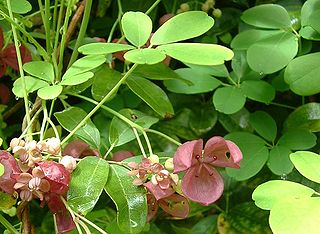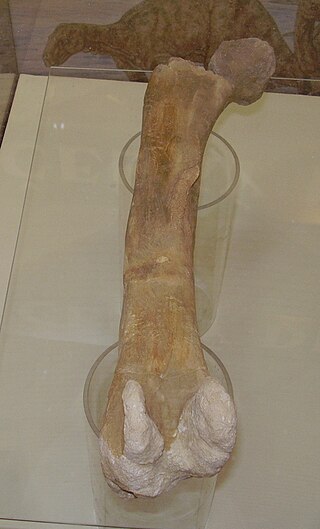
The Nymphaeales are an order of flowering plants, consisting of three families of aquatic plants, the Hydatellaceae, the Cabombaceae, and the Nymphaeaceae. It is one of the three orders of basal angiosperms, an early-diverging grade of flowering plants. At least 10 morphological characters unite the Nymphaeales. One of the traits is the absence of a vascular cambium, which is required to produce both xylem (wood) and phloem, which therefore are missing. Molecular synapomorphies are also known.

The Elaeagnaceae are a plant family, the oleaster family, of the order Rosales comprising small trees and shrubs, native to temperate regions of the Northern Hemisphere, south into tropical Asia and Australia. The family has about 60 species in three genera.

Gnetophyta is a division of plants, grouped within the gymnosperms, that consists of some 70 species across the three relict genera: Gnetum, Welwitschia, and Ephedra. The earliest unambiguous records of the group date to the Jurassic, and they achieved their highest diversity during the Early Cretaceous. The primary difference between gnetophytes and other gymnosperms is the presence of vessel elements, a system of small tubes (xylem) that transport water within the plant, similar to those found in flowering plants. Because of this, gnetophytes were once thought to be the closest gymnosperm relatives to flowering plants, but more recent molecular studies have brought this hypothesis into question, with many recent phylogenies finding them to be nested within the conifers.

The family Prophalangopsidae are insects belonging to the order Orthoptera. They are the only extant members of the superfamily Hagloidea. There is only one extant genus in North America, where they are known as grigs, four genera in Asia, and many extinct genera.

The Early Cretaceous or the Lower Cretaceous is the earlier or lower of the two major divisions of the Cretaceous. It is usually considered to stretch from 143.1 Ma to 100.5 Ma.

Lardizabalaceae is a family of flowering plants.

The Peruc–Korycany Formation is a geologic unit of Upper Cretaceous age, located mostly in the Czech Republic. It is the oldest unit of the Bohemian Cretaceous Basin, which overlies Silurian-aged metamorphosed rocks of the Bohemian Massif. It consists of fluvial to shallow marine sediments.

Brachyphyllum is a form genus of fossil coniferous plant foliage. Plants of the genus have been variously assigned to several different conifer groups including Araucariaceae and Cheirolepidiaceae. They are known from around the globe from the Late Carboniferous to the Late Cretaceous periods. The type species B. sattlerae was named after the fictional palaebotanist Ellie Sattler from the Jurassic Park franchise.
The Khilok Formation is an Early Cretaceous geologic formation in Buryatia, Russia. While the lower portion of the formation consists of sandstone and conglomerates, the upper portion of the formation largely consists of trachybasalt, these deposits have been dated to the Aptian. A thin 20 cm bed is known from the formation containing the remains of numerous indeterminate vertebrates, including dinosaur and pterosaurs and an indeterminate species of Kirgizemys.
Drewria potomacensis is a Cretaceous megafossil member of the Gnetales, from the Potomac Group, hence its name. It was possibly a shrub. It is the only known species in the genus Drewria.
This article records new taxa of plants that are scheduled to be described during the year 2017, as well as other significant discoveries and events related to paleobotany that are scheduled to occur in the year 2017.

Proctotrupidae is a family of parasitic wasps in the superfamily Proctotrupoidea. There are about 400 species in more than 30 genera in Proctotrupidae, found throughout most of the world.
Else Marie Friis is a Danish botanist and paleontologist. She is Professor Emerita in the Department of Geoscience at Aarhus University. Her work has been fundamental in the phylogenetic analysis of angiosperms, with widespread application to reproductive biology.
This article records new taxa of plants that were described during the year 2014, as well as other significant discoveries and events related to paleobotany that occurred in the year 2014.
This article records new taxa of fossil plants that are scheduled to be described during the year 2020, as well as other significant discoveries and events related to paleobotany that are scheduled to occur in the year 2020.
Mesoblattinidae is an extinct, problematic family of cockroaches known from the Mesozoic. It was formerly considered a wastebasket taxon for Mesozoic cockroaches, but the family has subsequently been better defined, with many taxa transferred to Caloblattinidae. It is considered to have close affinities with Blattidae and Ectobiidae, as well as possibly Blaberidae. The family first appeared by the Early Jurassic. They are considered to represent amongst the oldest groups of modern cockroaches, and like them are thought to have laid oothecae. Due to the poor ability of forewing venation to correctly classify cockroaches to extensive homoplasy, the value of this family as a taxonomic unit has been strongly questioned, with some authors considering the family a nomen dubium.

Zhangsolvidae is an extinct family of brachyceran flies known from the Cretaceous period. Members of the family possess a long proboscis, varying in length between 1.3 and 7 mm depending on the species, and were probably nectarivores. A specimen has been found with preserved Bennettitales pollen, suggesting that they acted as pollinators for extinct gymnosperms. They are considered to be members of the Stratiomyomorpha.
Paisia is an extinct genus of eudicot plants from the Cretaceous period. Found in the Almargem Formation, Early Cretaceous near Catefica, Portugal, it was first named by Else Marie Friis, Mário Miguel Mendes and Kaj Raunsgaard Pedersen in 2018. The type species is Paisia pantoporata.
Monetianthus mirus was a species of fossil plant, which occurred in the early Cretaceous period of Portugal.

Ptilozamites is an extinct genus of pteridosperm, known from the Triassic and Early Jurassic of the Northern Hemisphere. It is associated with the pollen organ Harrisiothecium.











